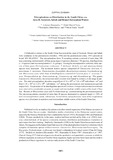| dc.contributor.author | Shamsudin, Lokman | |
| dc.contributor.author | Yasin, Abdul Hamid | |
| dc.contributor.author | Razak, Solahuddin Abdul | |
| dc.contributor.author | Yusoff, Mohd Shukri | |
| dc.date.accessioned | 2019-01-17T04:22:27Z | |
| dc.date.available | 2019-01-17T04:22:27Z | |
| dc.date.issued | 1999 | |
| dc.identifier.citation | Shamsudin, L., Yasin, A. H., Razak, S. A., & Yusoff, M. S. (1999). Microplankton on distribution in the South China Sea, Area II: Sarawak, Sabah and Brunei Darussalam waters. In Proceedings of the Second Technical Seminar on Marine Fishery Resources Survey in the South China Sea, Area II: West Coast of Sabah, Sarawak and Brunei Darussalam, 14-15 December 1998, Kuala Lumpur, Malaysia (pp. 197-223). Samut Prakan, Thailand: Training Department, Southeast Asian Fisheries Development Center. | en |
| dc.identifier.uri | http://hdl.handle.net/20.500.12067/820 | |
| dc.description.abstract | Collaborative cruises in the South China Sea around the coast of Sarawak, Brunei and Sabah were conducted in the premonsoon (October, 1996) and the postmonsoon (June, 1997) periods on board MV SEAFDEC. The microplankton from 79 sampling stations consisted of more than 200 taxa consisting predominantly of blue green algae (3 species), diatoms (> 90 species), dinoflagellates (> 70 species) and microzooplankton (> 20 groups). Among the microplankton collected, three species of blue green (Trichodesmium erythraeum, T. thiebautii, Richelia sp.) and numerous diatom species were dominant. The dominant diatom species comprised of Chaetoceros diversum, C. peruvianum, C. laciniosus, Thalassionema frauenfeldii, Bacteriastrum comosun, Coscinodiscus sp. and Rhizosolenia alata; while those of dinoflagellates consisted of Ceratium fusus, C. arcuatum, C. teres, Protoperidinium sp., Protoceratium sp., Ceratocorys sp. and Alexandrium sp. The genera Chaetoceros, Rhizosolenia, Bacteriastrum and Ceratium were found to contain a wide range of species. The total microplankton densities ranged from 0.74 x 106 to 7.94 x 106 individuals / m3 and from 0.16 x 106 to 1.25 x 106 individuals / m3 during the premonsoon and postmonsoon periods respectively. The presence of the dinoflagellate species of Ceratium, Protoperidinium and Alexandrium were detected in considerable amounts at coastal and intermediate middle waters of the South China Sea. Blooms of Rhizosolenia alata and Trichodesmium sp. occurred during the premonsoon period. The microzooplankton consisted of more than 20 species dominated by copepod nauplii (> 50% of total microzooplankton count), radiolerians, foraminiferas and protozoans; most of the zooplankton species were dominant in nearshore and intermediate middle waters of the South China Sea. | en |
| dc.language.iso | en | en |
| dc.publisher | Training Department, Southeast Asian Fisheries Development Center | en |
| dc.subject | South China Sea | en |
| dc.subject | Malaysia | en |
| dc.subject | Sarawak | en |
| dc.subject | Sabah | en |
| dc.subject | Brunei Darussalam | en |
| dc.subject | Trichodesmium | |
| dc.subject | Bacillariophyta | |
| dc.subject | Trichodesmium thiebautii | |
| dc.subject | Richelia | |
| dc.title | Microplankton on Distribution in the South China Sea, Area II: Sarawak, Sabah and Brunei Darussalam Waters | en |
| dc.type | Conference paper | en |
| dc.citation.spage | 197 | |
| dc.citation.epage | 223 | |
| dc.subject.asfa | dominant species | en |
| dc.subject.asfa | species diversity | en |
| dc.subject.asfa | zooplankton | en |
| dc.subject.asfa | biological sampling | en |
| dc.citation.conferenceTitle | Proceedings of the Second Technical Seminar on Marine Fishery Resources Survey in the South China Sea, Area II: West Coast of Sabah, Sarawak and Brunei Darussalam, 14-15 December 1998, Kuala Lumpur, Malaysia | en |

